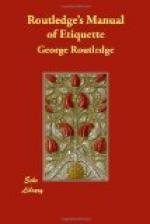* * * * *
A vos places, back to your own places.
A la fin, at the end.
A droite, to the right.
A gauche, to the left.
Balancez, set to your partners.
Balancez aux coins, set to the corners.
Balancez quatre en ligne, four dancers set in a line, joining hands, as in La Poule.
Balancez en moulinet, gentlemen and their partners give each other right hands across, and balancez in the form of a cross.
Balancez et tour des mains, all set to partners,
and turn to places.
(See Tour des mains.)
Ballotez, do the same step four times without changing your place.
Chaine Anglaise, opposite couples right and left.
Chaine des dames, ladies’ chain.
Chaine Anglaise double, double right and left.
Chaine des dames double, all the ladies perform the ladies’ chain at the same time.
Chassez croisez, do the chasse step from left to right, or right to left, the lady passing before the gentleman in the opposite direction, that is, moving right if he moves left, and vice versa.
Chassez croisez et dechassez, change places with partners, ladies passing in front, first to the right, then to the left, back to places. It may be either a quatre four couples—or les huit—eight couples.
Chassez a droite—a gauche, move to the right—to the left.
Le cavalier seul, gentleman advances alone.
Les cavaliers seuls deux fois, gentlemen advance and retire twice without their partners.
Changez vos dames, change partners.
Contre partie pour les autres, the other dancers do the same figure.
Demi promenade, half promenade.
Demi chaine Anglaise, half right and left.
Demi moulinet, ladies all advance to centre, right hands across, and back to places.
Demi tour a quatre, four hands half round.
Dos-a-dos, lady and opposite gentleman advance, pass round each other back to back, and return to places.
Les dames en moulinet, ladies give right hands across to each other, half round, and back again with left hands.
Les dames donnent la main droite—gauche—a leurs cavaliers, ladies give the right—left—hands to partners.
En avant deux et en arriere; first lady and vis-a-vis gentleman advance and retire. To secure brevity, en avant is always understood to imply en arriere when the latter is not expressed.
En avant deux fois, advance and retreat twice.
En avant quatre, first couple and their vis-a-vis advance and retire.
En avant trois, three advance and retire, as in La Pastorale.




